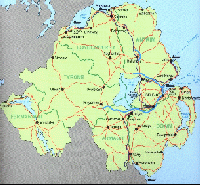


Pickenses in Ulster
(Much of this was copied directly from the internet.
I don't remember where I copied it from.)
Map of Ulster, Northern Ireland

County Derry (Doire "oak grove")
Originally part of the region known as Tír Eoghain, "Eoghan's land",
after one of the sons of the semi-legendary Niall of the Nine Hostages,
much of the land remained in the hands of the O'Kanes (or O'Cahans)
until the seventeenth century.
In 1610, under some duress from James I, the livery companies of the
city of London agreed to oversee the colonisation of the area, and in
1610 the county of Londonderry was established. The old inhabitants
were expropriated, new towns established and an influx of English
and Scottish settlers began. Understandably under the circumstances,
the name of the city and county remains somewhat sensitive, "Derry"
to the descendants of the old Gaelic and Catholic natives, "Londonderry"
to the descendants of the settlers. Attempts at evenhandedness,
involving the convoluted "Derry/Londonderry city", spoken as
"Derry-stroke-Londonderry city", have led to the sardonic local
shorthand "Stroke city".
The city is one of the most beautifully situated in Ireland, on a
hilltop overlooking Lough Foyle.
The Province of Ulster (Ulaidh)
Ulster is the most northerly of the four historic provinces. It consists
of counties Antrim, Armagh, Cavan, Derry, Donegal, Down, Fermanagh,
Monaghan and Tyrone. Although the name is now often used as shorthand
for Northern Ireland, three of its counties, Cavan, Donegal and Monaghan,
are part of the Republic of Ireland.
In the earliest known division, the province covered a slightly different
territory, excluding much of what is now Cavan and coming as far south as
Louth. The capital was situated at Emhain Mhacha, outside Armagh. Attacks
from its southern neighbour Mide (Meath) in the fourth century AD broke
it up into smaller kingdoms: Tír Chonaill covering most of Donegal; Tír
Eoghain covering most of modern Tyrone and Derry; Oriel which included
Monaghan, Louth and Armagh; and Uladh which, although claiming the name
of the province as a whole, in fact only incorporated the north-eastern
counties.
The Normans managed to settle along the east coast from the twelfth
century, but the power of the O'Neills and O'Donnells remained intact
elsewhere in the province until the seventeenth century when the final
collapse of the old Gaelic civilisation led to the Plantation of Ulster
and a massive influx of settlers from Scotland and England.
This is when the Edinburgh Pickenses went to Ireland. The 1620's and
1630's saw a great influx of Pickenses to the Ulster area. Their names
were all spelled differently but were mostly "Pikken". Other spellings
included Pikan, Pickan, and Picon.
The first great mass migration from Ireland to North America took place
from Ulster in the eighteenth century (1700's) and consisted of the
descendants of the Scottish settlers seeking refuge from economic and
political hardship and religious intolerance.
William Henry and Thomas Pickens (sons of Robert and Ester) were among
these migrators to America. This is the line that so many of the famous
southern Pickenses came from. I believe our line came from here too but
it is difficult to get old Irish records without either going there or
paying a lot of money or both. Alexander must have been the grandson
of one of William Henry's brothers, and went back to Campbeltown
Scotland to raise a family. That is why there is no birth record
of Alexander in Scotland.
